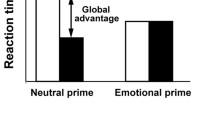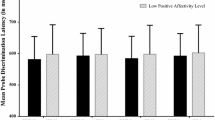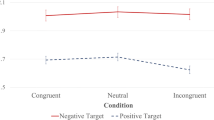Abstract
In models of affect and cognition, it is held that positive affect broadens the scope of attention. Consistent with this claim, previous research has indeed suggested that positive affect is associated with impaired selective attention as evidenced by increased interference of spatially distant distractors. However, several recent findings cast doubt on the reliability of this observation. In the present study, we examined whether selective attention in a visual flanker task is influenced by positive mood induction. Across three experiments, positive affect consistently failed to exert any impact on selective attention. The implications of this null-finding for theoretical models of affect and cognition are discussed.

Similar content being viewed by others
Notes
We also used the outlier analyses of Rowe et al. (2007) in which response times >1,000 ms were considered as outliers. Results were comparable.
References
Ashby, F. G., Isen, A. M., & Turken, U. (1999). A neuropsychological theory of positive affect and its influence on cognition. Psychological Review, 106, 529–550.
Baas, M., De Dreu, C. K. W., & Nijstad, B. A. (2008). A meta-analysis of 25 years of mood-creativity research: Hedonic tone, activation, or regulatory focus? Psychological Bulletin, 134, 779–806.
Borenstein, M., Hedges, L. V., Higgins, J. P. T., & Rothstein, H. R. (2009). Introduction to meta-analysis. Chichester: Wiley.
Burton, C. M., & King, L. A. (2009). The health benefits of writing about positive experiences: The role of broadened cognition. Psychology and Health, 24, 867–879.
Chajut, E., & Algom, D. (2003). Selective attention improves under stress: Implications for theories of social cognition. Journal of Personality and Social Psychology, 85, 231–248.
Cohen, J. (1988). Statistical power analysis for the behavioral sciences. Hillsdale: Lawrence Erlbaum Associates.
Compton, R. J., Wirtz, D., Pajoumand, G., Claus, E., & Heller, W. (2004). Association between positive affect and attentional shifting. Cognitive Therapy and Research, 28, 733–744.
Derryberry, D., & Tucker, D. M. (1994). Motivating the focus of attention. In P. M. Niedenthal & S. Kitayama (Eds.), The heart’s eye: Emotional influences in perception and attention (pp. 167–196). San Diego: Academic Press.
Dickerson, S. S., & Kemeny, M. E. (2004). Acute stressors and cortisol responses: A theoretical integration and synthesis of laboratory research. Psychological Bulletin, 130, 355–391.
Easterbrook, J. A. (1959). The effect of emotion on cue utilization and the organization of behavior. Psychological Review, 66, 183–201.
Eriksen, B. A., & Eriksen, C. W. (1974). Effects of noise letters upon identification of a targetletter in a nonsearch task. Perception & Psychophysics, 16, 143–149.
Estrada, C. A., Isen, A. M., & Young, M. J. (1994). Positive affect improves creative problem solving and influences reported source of practice satisfaction in physicians. Motivation and Emotion, 18, 285–299.
Estrada, C. A., Isen, A. M., & Young, M. J. (1997). Positive affect facilitates integration of information and decreases anchoring in reasoning among physicians. Organizational Behavior and Human Decision Processes, 72, 117–135.
Fan, J., McCandliss, B. D., Sommer, T., Raz, A., & Posner, M. I. (2002). Testing the efficiency and independence of attentional networks. Journal of Cognitive Neuroscience, 14, 340–347.
Finucane, A. M., Whiteman, M. C., & Power, M. J. (2010). The effect of happiness and sadness on alerting, orienting, and executive attention. Journal of Attention Disorders, 13, 629–639.
Fredrickson, B. L. (1998). What good are positive emotions? Review of General Psychology, 2, 300–319.
Fredrickson, B. L. (2001). The role of positive emotions in positive psychology—The broaden-and-build theory of positive emotions. American Psychologist, 56, 218–226.
Fredrickson, B. L., & Braningan, C. (2005). Positive emotions broaden the scope of attention and thought-action repertoires. Cognition and Emotion, 19, 313–332.
Gable, P. A., & Harmon-Jones, E. (2008). Approach-motivated positive affect reduces breadth of attention. Psychological Science, 19, 476–482.
Gable, P. A., & Harmon-Jones, E. (2010). The blues broaden but the nasty narrows: Attentional consequences of negative affects low and high in motivational intensity. Psychological Science, 21, 211–215.
Gasper, K. (2004). Do you see what I see? Affect and visual information processing. Cognition and Emotion, 18, 405–421.
Gasper, K., & Clore, G. L. (2002). Attending to the big picture: Mood and global versus local processing of visual information. Psychological Science, 13, 34–40.
Green, J. D., Sedikides, C., Saltzberg, J. A., Wood, J. V., & Forzano, L. A. (2003). Happy mood decreases self-focused attention. British Journal of Social Psychology, 42, 147–157.
Harmon-Jones, E., & Gable, P. A. (2009). Neural activity underlying the effect of approach-motivated positive affect on narrowed attention. Psychological Science, 20, 406–409.
Huntsinger, J. R., Clore, G. L., & Bar-Anan, Y. (2010). Mood and global-local focus: Priming a local focus reverses the link between mood and global-local processing. Emotion, 10, 722–726.
Isen, A. M. (2001). An influence of positive affect on decision making in complex situations: Theoretical issues with practical implications. Journal of Consumer Psychology, 11, 75–85.
Jennings, P. D., McGinnis, D., Lovejoy, S., & Stirling, J. (2000). Valence and arousal ratings for Velten mood induction statements. Motivation and Emotion, 24, 285–297.
Johnson, K. J., Waugh, C. E., & Fredrickson, B. L. (2010). Smile to see the forest: Facially expressed positive emotions broaden cognition. Cognition and Emotion, 24, 299–321.
Martin, E. A., & Kerns, J. G. (2011). The influence of positive mood on different aspects of cognitive control. Cognition and Emotion, 25, 265–279.
Merritt, P., Hirshman, E., Wharton, W., Stangl, B., Devlin, J., & Lenz, A. (2007). Evidence for gender differences in visual selective attention. Personality and individual differences, 43, 597–609.
Moriya, J., & Tanno, Y. (2009). Dysfunction of attentional networks for non-emotional processing in negative affect. Cognition and Emotion, 23, 1090–1105.
Nummenmaa, L., & Niemi, P. (2004). Inducing affective states with success–failure manipulations: A meta-analysis. Emotion, 4, 207–214.
Olivers, C. N. L., & Nieuwenhuis, S. (2005). The beneficial effects of concurrent task-irrelevant mental activity on temporal attention. Psychological Science, 16, 265–269.
Pacheco-Unguetti, A. P., Acosta, A., Callejas, A., & Lupianez, J. (2010). Attention and anxiety: Different attentional functioning under state and trait anxiety. Psychological Science, 21, 298–304.
Posner, M. I., & Petersen, S. E. (1990). The attention system of the human brain. Annual Review of Neuroscience, 13, 25–42.
Rottenberg, J., Ray, R. D., & Gross, J. J. (2007). Emotion elicitation using films. In J. A. Coan & J. J. B. Allen (Eds.), The handbook of emotion elicitation and assessment. London: Oxford University Press.
Rowe, G., Hirsh, J. B., & Anderson, A. J. (2007). Positive affect increases the breadth of attentional selection. Proceedings of the National Academy of Sciences of the United States of America, 104, 383–388.
Russell, J. A., Weis, A., & Mendelsohn, G. A. (1989). Affect grid: a single-item scale of pleasure and arousal. Journal of Personality and Social Psychology, 57, 493.
Valdez, P., Ramirez, C., Garcia, A., Talamantes, J., Armijo, P., & Borrani, J. (2005). Circadian rhythms in components of attention. Biological rhythm research, 36, 57–65.
Van Wouwe, N. C., Band, G. P. H., & Ridderinkhof, K. R. (2011). Positive affect modulates flexibility and evaluative control. Journal of Cognitive Neuroscience, 23, 524–539.
Watson, D., & Tellegen, A. (1985). Toward a consensual structure of mood. Psychological Bulletin, 98, 219–235.
Westermann, R., Spies, K., Stahl, G., & Hesse, F. W. (1996). Relative effectiveness and validity of mood induction procedures: A meta-analysis. European Journal of Social Psychology, 26, 557–580.
Wood, J. V., Saltzberg, J. A., & Goldsamt, L. A. (1990). Does affect induce self-focused attention. Journal of Personality and Social Psychology, 58, 899–908.
Acknowledgments
Preparation of this paper was partially supported by Grant BOF10/GOA/014 for a Concerted Research Action of Ghent University (awarded to Rudi De Raedt and Ernst Koster) and by a grant from the Netherlands Organization for Scientific Research (awarded to Guido Band).
Author information
Authors and Affiliations
Corresponding author
Rights and permissions
About this article
Cite this article
Bruyneel, L., van Steenbergen, H., Hommel, B. et al. Happy but still focused: failures to find evidence for a mood-induced widening of visual attention. Psychological Research 77, 320–332 (2013). https://doi.org/10.1007/s00426-012-0432-1
Received:
Accepted:
Published:
Issue Date:
DOI: https://doi.org/10.1007/s00426-012-0432-1




